brake light MERCEDES-BENZ G-Class 2014 W463 Owner's Manual
[x] Cancel search | Manufacturer: MERCEDES-BENZ, Model Year: 2014, Model line: G-Class, Model: MERCEDES-BENZ G-Class 2014 W463Pages: 354, PDF Size: 7.63 MB
Page 6 of 354
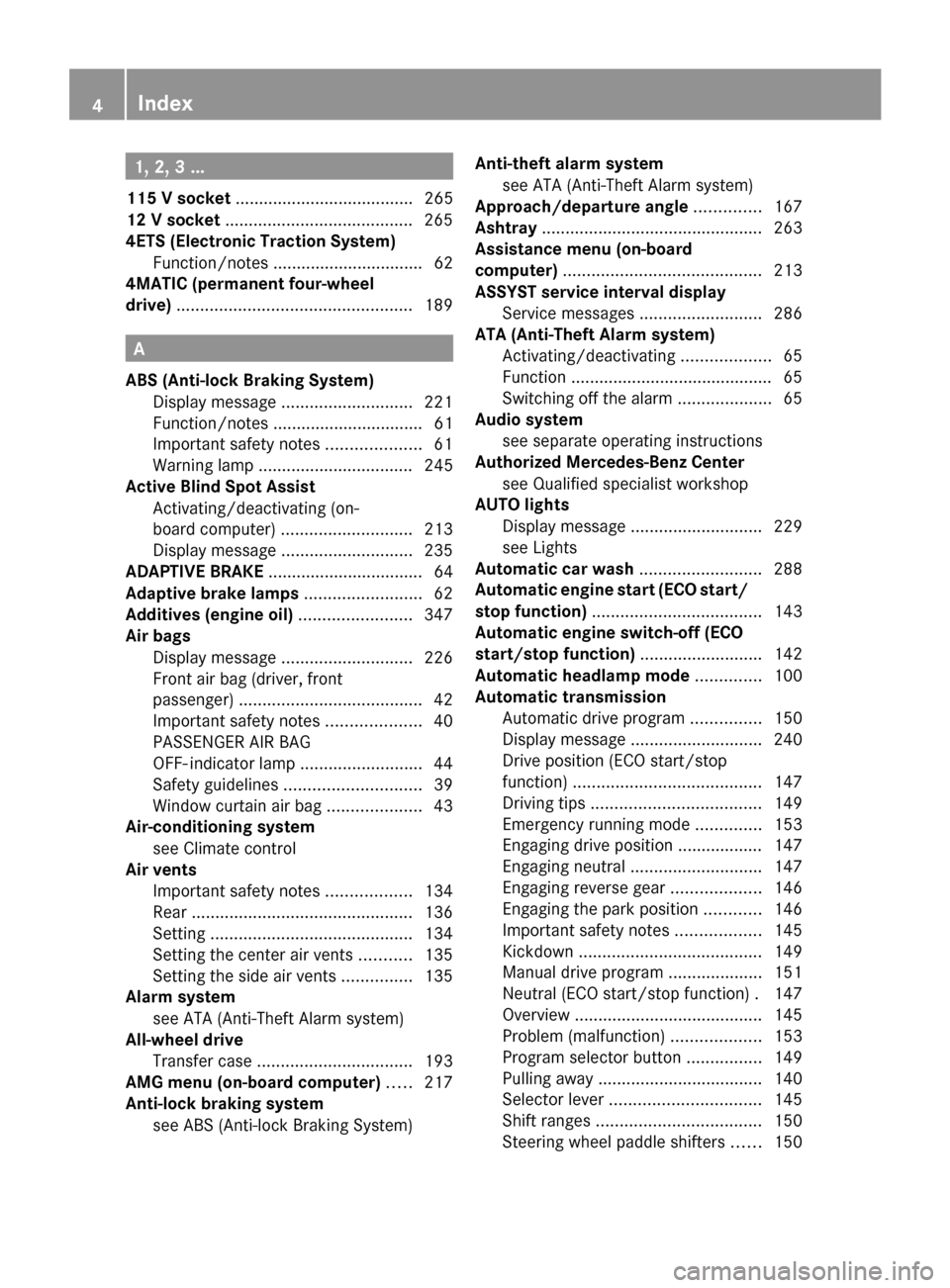
1, 2, 3 ...
115 V socket ...................................... 265
12 V socket ........................................ 265
4ETS (Electronic Traction System) Function/notes ................................ 62
4MATIC (permanent four-wheel
drive) .................................................. 189A
ABS (Anti-lock Braking System) Display message ............................ 221
Function/notes ................................ 61
Important safety notes ....................61
Warning lamp ................................. 245
Active Blind Spot Assist
Activating/deactivating (on-
board computer) ............................ 213
Display message ............................ 235
ADAPTIVE BRAKE ................................. 64
Adaptive brake lamps .........................62
Additives (engine oil) ........................347
Air bags Display message ............................ 226
Front air bag (driver, front
passenger) ....................................... 42
Important safety notes ....................40
PASSENGER AIR BAG
OFF- indicator lamp ..........................44
Safety guidelines ............................. 39
Window curtain air bag ....................43
Air-conditioning system
see Climate control
Air vents
Important safety notes ..................134
Rear ............................................... 136
Setting ........................................... 134
Setting the center air vents ...........135
Setting the side air vents ...............135
Alarm system
see ATA (Anti-Theft Alarm system)
All-wheel drive
Transfer case ................................. 193
AMG menu (on-board computer) .....217
Anti-lock braking system see ABS (Anti-lock Braking System) Anti-theft alarm system
see ATA (Anti-Theft Alarm system)
Approach/departure angle ..............167
Ashtray ............................................... 263
Assistance menu (on-board
computer) .......................................... 213
ASSYST service interval display Service messages ..........................286
ATA (Anti-Theft Alarm system)
Activating/deactivating ...................65
Function .......................................... .65
Switching off the alarm ....................65
Audio system
see separate operating instructions
Authorized Mercedes-Benz Center
see Qualified specialist workshop
AUTO lights
Display message ............................ 229
see Lights
Automatic car wash ..........................288
Automatic engine start (ECO start/
stop function) .................................... 143
Automatic engine switch-off (ECO
start/stop function) ..........................142
Automatic headlamp mode ..............100
Automatic transmission Automatic drive program ...............150
Display message ............................ 240
Drive position (ECO start/stop
function) ........................................ 147
Driving tips .................................... 149
Emergency running mode ..............153
Engaging drive position .................. 147
Engaging neutral ............................ 147
Engaging reverse gear ...................146
Engaging the park position ............146
Important safety notes ..................145
Kickdown ....................................... 149
Manual drive program ....................151
Neutral (ECO start/stop function) .147
Overview ........................................ 145
Problem (malfunction) ...................153
Program selector button ................149
Pulling away ................................... 140
Selector lever ................................ 145
Shift ranges ................................... 150
Steering wheel paddle shifters ......150 4
Index
Page 7 of 354

Trailer towing
................................. 149
Transmission position displa y........ 146
Automatic transmission
emergency mode ............................... 153
Axle load, permissible (trailer
towing) ............................................... 352B
Backup lamp Changing bulbs .............................. 113
BAS (Brake Assist System) .................61
Battery Checking (SmartKey) .......................70
Important safety guidelines
(SmartKey) ....................................... 70
Replacing (SmartKey) ......................71
Battery (vehicle)
Charging ........................................ 301
Display message ............................ 231
Important safety notes ..................299
Jump starting ................................. 303
Overview ........................................ 299
Blind Spot Assist
Activating/deactivating .................213
Display message ............................ 235
Notes/function .............................. 186
Brake fluid
Display message ............................ 224
Notes ............................................. 347
Brake fluid level ................................ 286
Brake lamps Adaptive .......................................... .62
Display message ............................ 227
Brakes
ABS .................................................. 61
BAS .................................................. 61
Brake fluid (notes) .........................347
Display message ............................ 221
High-performance brake system ....161
Important safety notes ..................159
Maintenance .................................. 160
Parking brake ................................ 157
Riding tips ...................................... 159
Warning lamp ................................. 244
Breakdown
see Flat tire
see Towing away Brush guard
....................................... 274
Bulbs Backup lamp .................................. 113
Brake lamp .................................... 113
Cornering light function .................110
Fog lamps ...................................... 110
Rear fog lamp ................................ 113
Tail lamp ........................................ 113
see Replacing bulbs C
California Important notice for retail
customers and lessees ....................22
Calling up a malfunction
see Display messages
Care
Carpets .......................................... 294
Car wash ........................................ 288
Chrome parts ................................. 292
Display ........................................... 292
Gear or selector lever ....................292
Headlamps ..................................... 291
Interior ........................................... 292
Matte finish ................................... 290
Notes ............................................. 288
Paint .............................................. 289
Plastic trim .................................... 292
Power washer ................................ 289
Rear view camera .......................... 291
Roof lining ...................................... 294
Seat belt ........................................ 294
Seat covers .................................... 293
Sensors ......................................... 291
Steering wheel ............................... 292
Tail pipes ....................................... 292
Trim strips ..................................... 293
Washing by hand ........................... 289
Wheels ........................................... 289
Windows ........................................ 290
Wiper blades .................................. 291
Wooden trim .................................. 293
Cargo compartment cover
Installing/removing .......................261
Notes/how to use .........................261
Opening and closing ......................261
Overview ........................................ 261 Index
5
Page 15 of 354
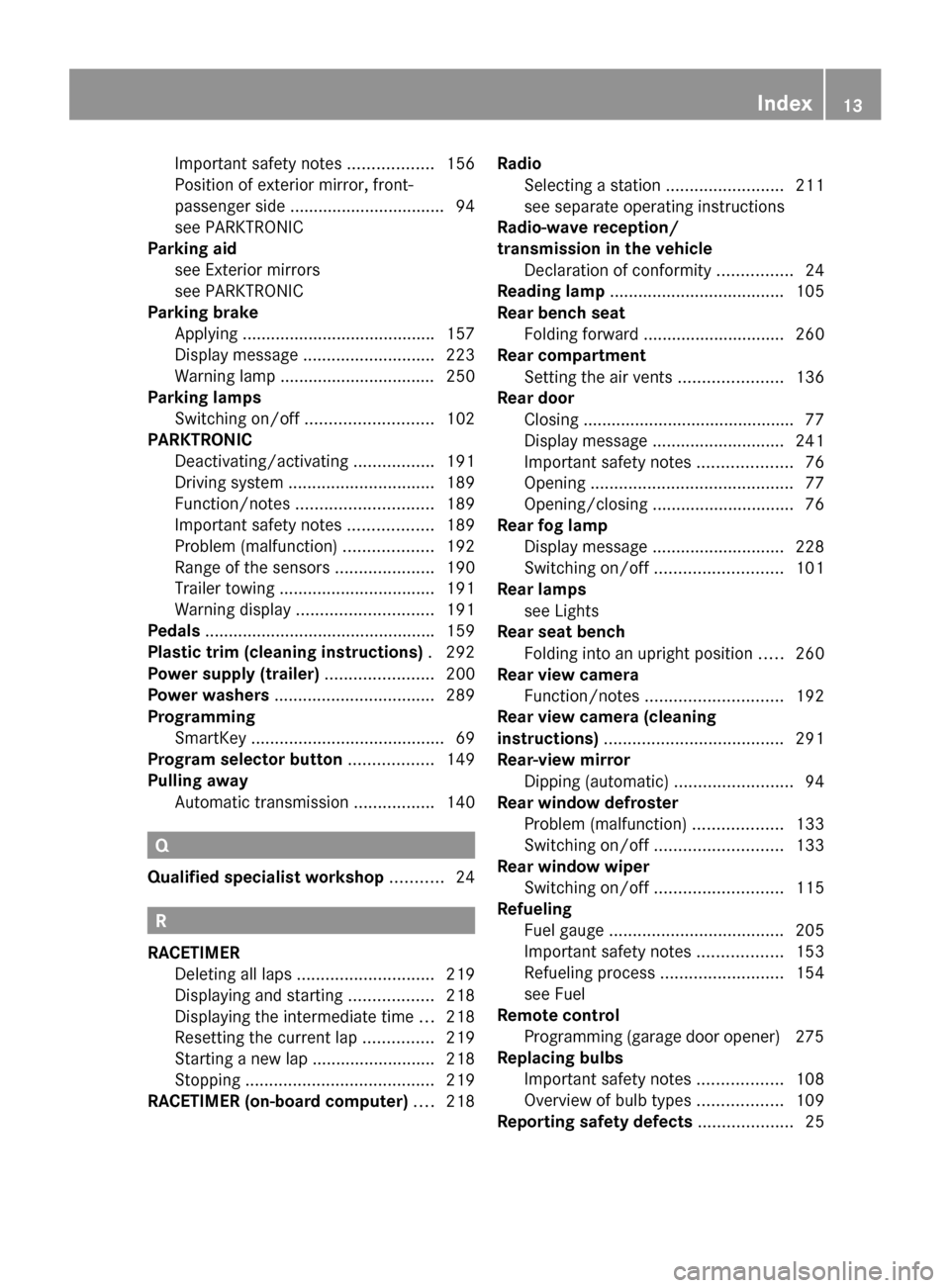
Important safety notes
..................156
Position of exterior mirror, front-
passenger side ................................. 94
see PARKTRONIC
Parking aid
see Exterior mirrors
see PARKTRONIC
Parking brake
Applying ........................................ .157
Display message ............................ 223
Warning lamp ................................. 250
Parking lamps
Switching on/off ........................... 102
PARKTRONIC
Deactivating/activating .................191
Driving system ............................... 189
Function/notes ............................. 189
Important safety notes ..................189
Problem (malfunction) ...................192
Range of the sensors .....................190
Trailer towing ................................. 191
Warning displa y............................. 191
Pedals ................................................ .159
Plastic trim (cleaning instructions) .292
Power supply (trailer) .......................200
Power washers .................................. 289
Programming SmartKey ......................................... 69
Program selector button ..................149
Pulling away Automatic transmission .................140 Q
Qualified specialist workshop ...........24 R
RACETIMER Deleting all laps ............................. 219
Displaying and starting ..................218
Displaying the intermediate time ...218
Resetting the current lap ...............219
Starting a new lap ..........................218
Stopping ........................................ 219
RACETIMER (on-board computer) ....218 Radio
Selecting a station .........................211
see separate operating instructions
Radio-wave reception/
transmission in the vehicle
Declaration of conformity ................24
Reading lamp ..................................... 105
Rear bench seat Folding forward .............................. 260
Rear compartment
Setting the air vents ......................136
Rear door
Closing ............................................ .77
Display message ............................ 241
Important safety notes ....................76
Opening ........................................... 77
Opening/closing .............................. 76
Rear fog lamp
Display message ............................ 228
Switching on/off ........................... 101
Rear lamps
see Lights
Rear seat bench
Folding into an upright position .....260
Rear view camera
Function/notes ............................. 192
Rear view camera (cleaning
instructions) ...................................... 291
Rear-view mirror Dipping (automatic) .........................94
Rear window defroster
Problem (malfunction) ...................133
Switching on/off ........................... 133
Rear window wiper
Switching on/off ........................... 115
Refueling
Fuel gauge ..................................... 205
Important safety notes ..................153
Refueling proces s.......................... 154
see Fuel
Remote control
Programming (garage door opener) 275
Replacing bulbs
Important safety notes ..................108
Overview of bulb type s.................. 109
Reporting safety defects ....................25 Index
13
Page 35 of 354
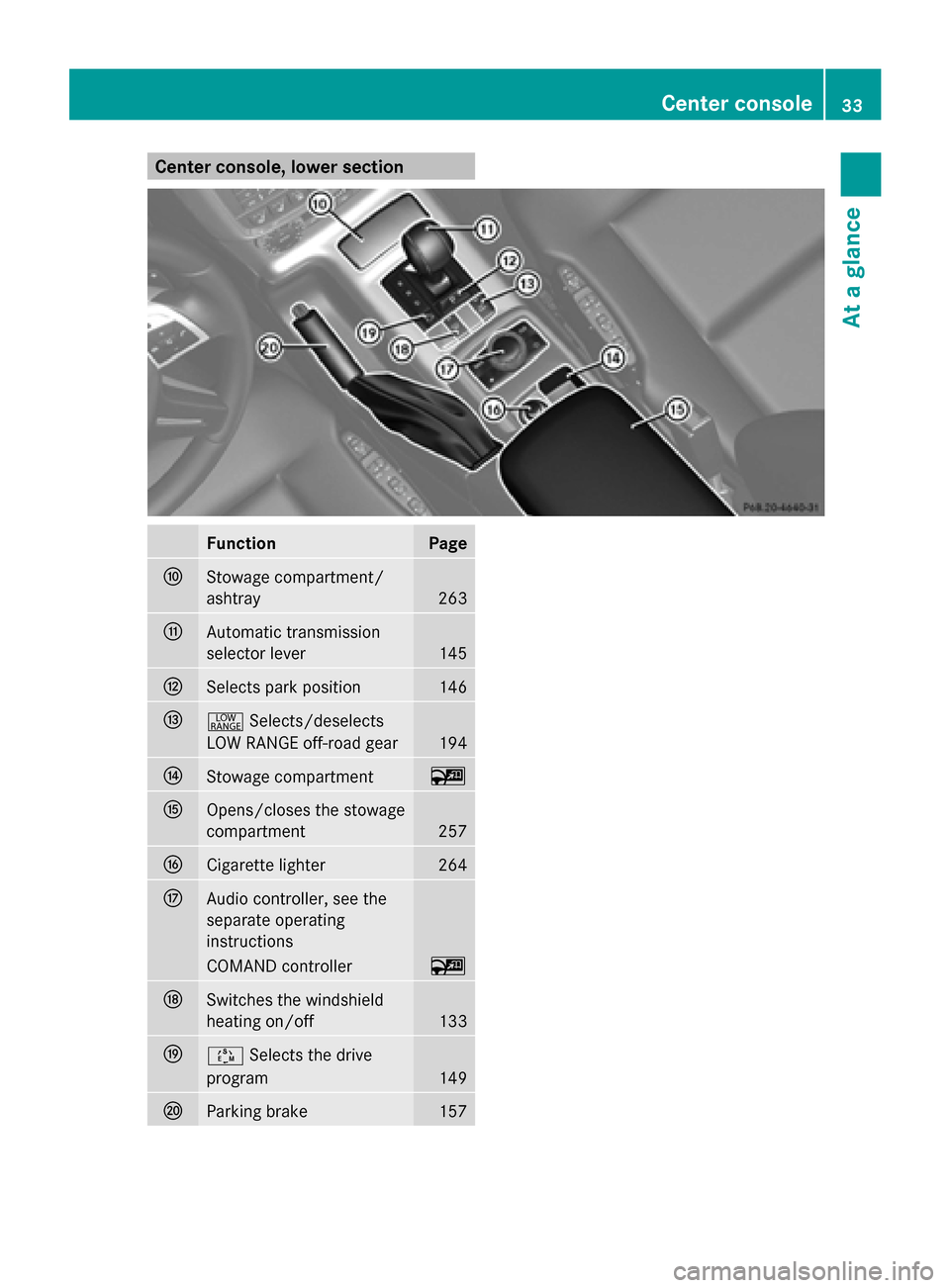
Center console, lower section
Function Page
006E
Stowage compartment/
ashtray
263
006F
Automatic transmission
selector lever 145
0070
Selects park position 146
0071
002E
Selects/deselects
LOW RANGE off-road gear 194
0072
Stowage compartment 00FC
0073
Opens/closes the stowage
compartment 257
0074
Cigarette lighter 264
0075
Audio controller, see the
separate operating
instructions
COMAND controller 00FC
0076
Switches the windshield
heating on/off
133
0077
00C8
Selects the drive
program 149
0078
Parking brake 157 Center console
33At a glance
Page 62 of 354

Override feature for the rear side
windows
G
WARNING
When children ride on the vehicle's rear seats,
activate the override switch. Otherwise, the
children could be injured, e.g. by trapping
themselves in the rear side window. X
To activate/deactivate: press button0043.
If indicator lamp 0044is lit, operation of the
rear side windows is disabled. Operation is
only possible using the switches in the
driver's door. If indicator lamp 0044is off,
operation is possible using the switches in
the rear compartment. Driving safety systems
Overview of driving safety systems
In this section, you will find information about
the following driving safety systems:
R ABS (Anti-lock BrakingSystem)
(Y page 61)
R BAS (Brake AssistSystem) (Y page 61)
R Adaptive brake lights (Y page 62)
R ESP ®
(Electronic StabilityProgram)
(Y page 62)
R EBD ( Electronic Brake force Distribution)
(Y page 64)
R ADAPTIVE BRAKE (Y page 64)
R Trailer stabilization Important safety notes
G
WARNING
The ABS, the BAS, and the ESP ®
switch off
when the differential locks are switched on.
When the ABS, the BAS, and the ESP ®
are
switched off
R wheels may lock during hard braking
R steering capabilities are reduced
R braking distance is increased
R vehicle stability in standard driving
maneuvers is increased
Make sure the differential locks are switched
on at all times except when driving off-road
for example. Switch on the differential locks
immediately when returning from off-road
driving.
If you fail to adapt your driving style or
become distracted, the driving safety
systems can neither reduce the risk of
accident nor override the laws of physics.
Driving safety systems are merely aids
designed to assist driving. You are
responsible for the distance to the vehicle in
front, for vehicle speed and for braking in
good time. Always adapt your driving style to
suit the prevailing road and weather
conditions and maintain a safe distance from
the vehicle in front. Drive carefully.
i Please note that the driving safety
systems described only work as effectively
as possible if there is adequate contact
between the tires and the road surface. Pay
particular attention to the information
regarding tires, recommended minimum
tire tread depths etc. in the "Wheels and
tires" section (Y page 312).
In wintry driving conditions, always use
winter tires (M+S tires) and if necessary,
snow chains. Only in this way will the
driving safety systems described in this
section work as effectively as possible. 60
Driving safety systemsSafety
Page 63 of 354
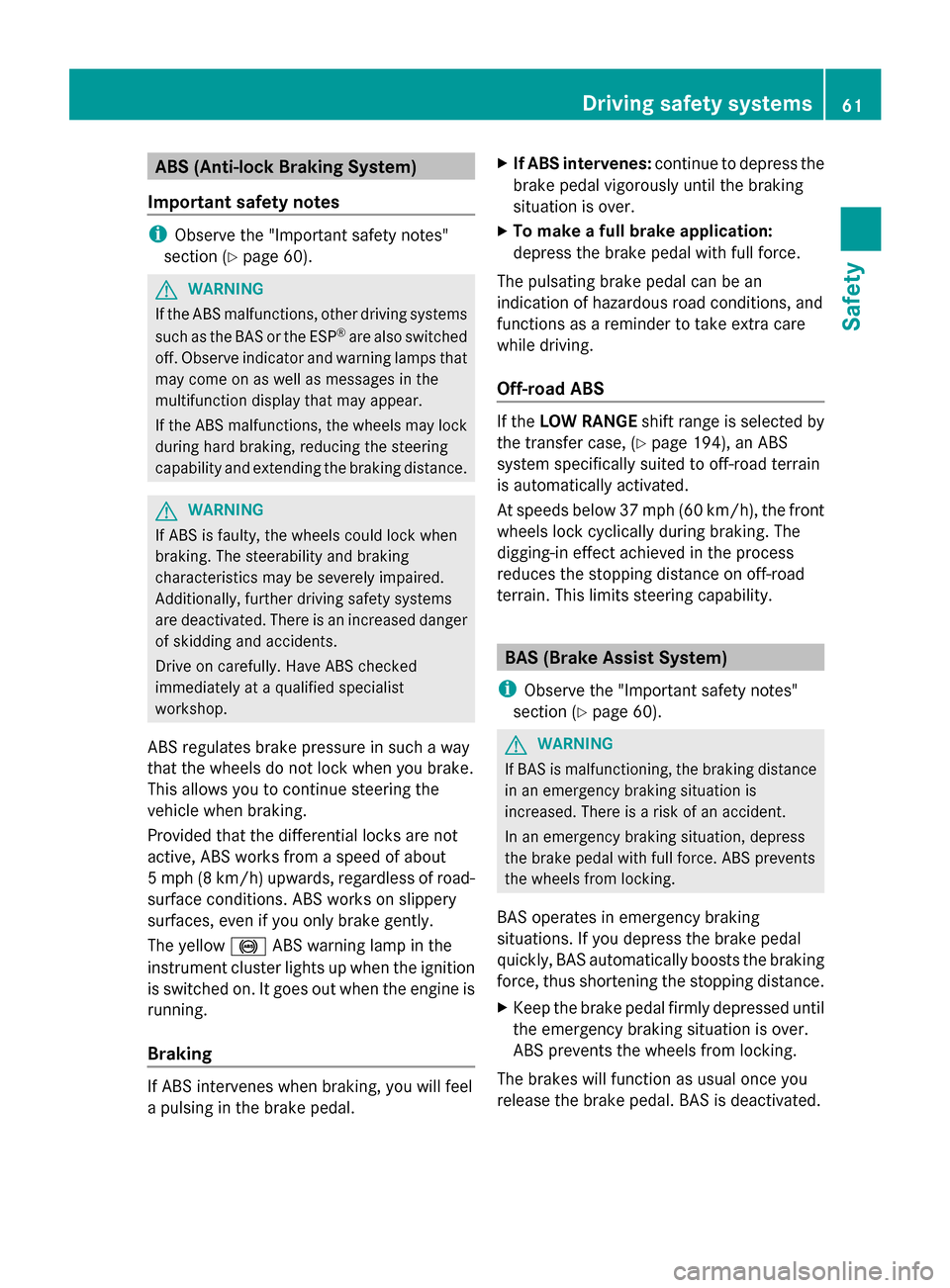
ABS (Anti-lock Braking System)
Important safety notes i
Observe the "Important safety notes"
section (Y page 60). G
WARNING
If the ABS malfunctions, other driving systems
such as the BAS or the ESP ®
are also switched
off. Observe indicator and warning lamps that
may come on as well as messages in the
multifunction display that may appear.
If the ABS malfunctions, the wheels may lock
during hard braking, reducing the steering
capability and extending the braking distance. G
WARNING
If ABS is faulty, the wheels could lock when
braking. The steerability and braking
characteristics may be severely impaired.
Additionally, further driving safety systems
are deactivated. There is an increased danger
of skidding and accidents.
Drive on carefully. Have ABS checked
immediately at a qualified specialist
workshop.
ABS regulates brake pressure in such a way
that the wheels do not lock when you brake.
This allows you to continue steering the
vehicle when braking.
Provided that the differential locks are not
active, ABS works from a speed of about
5 mph (8 km/h) upwards, regardless of road-
surface conditions. ABS works on slippery
surfaces, even if you only brake gently.
The yellow 0025ABS warning lamp in the
instrument cluster lights up when the ignition
is switched on. It goes out when the engine is
running.
Braking If ABS intervenes when braking, you will feel
a pulsing in the brake pedal. X
If ABS intervenes: continue to depress the
brake pedal vigorously until the braking
situation is over.
X To make a full brake application:
depress the brake pedal with full force.
The pulsating brake pedal can be an
indication of hazardous road conditions, and
functions as a reminder to take extra care
while driving.
Off-road ABS If the
LOW RANGE shift range is selected by
the transfer case, (Y page 194), an ABS
system specifically suited to off-road terrain
is automatically activated.
At speeds below 37 mph (60 km/h), the front
wheels lock cyclically during braking. The
digging-in effect achieved in the process
reduces the stopping distance on off-road
terrain. This limits steering capability. BAS (Brake Assist System)
i Observe the "Important safety notes"
section (Y page 60). G
WARNING
If BAS is malfunctioning, the braking distance
in an emergency braking situation is
increased. There is a risk of an accident.
In an emergency braking situation, depress
the brake pedal with full force. ABS prevents
the wheels from locking.
BAS operates in emergency braking
situations. If you depress the brake pedal
quickly, BAS automatically boosts the braking
force, thus shortening the stopping distance.
X Keep the brake pedal firmly depressed until
the emergency braking situation is over.
ABS prevents the wheels from locking.
The brakes will function as usual once you
release the brake pedal. BAS is deactivated. Driving safety systems
61Safety Z
Page 64 of 354
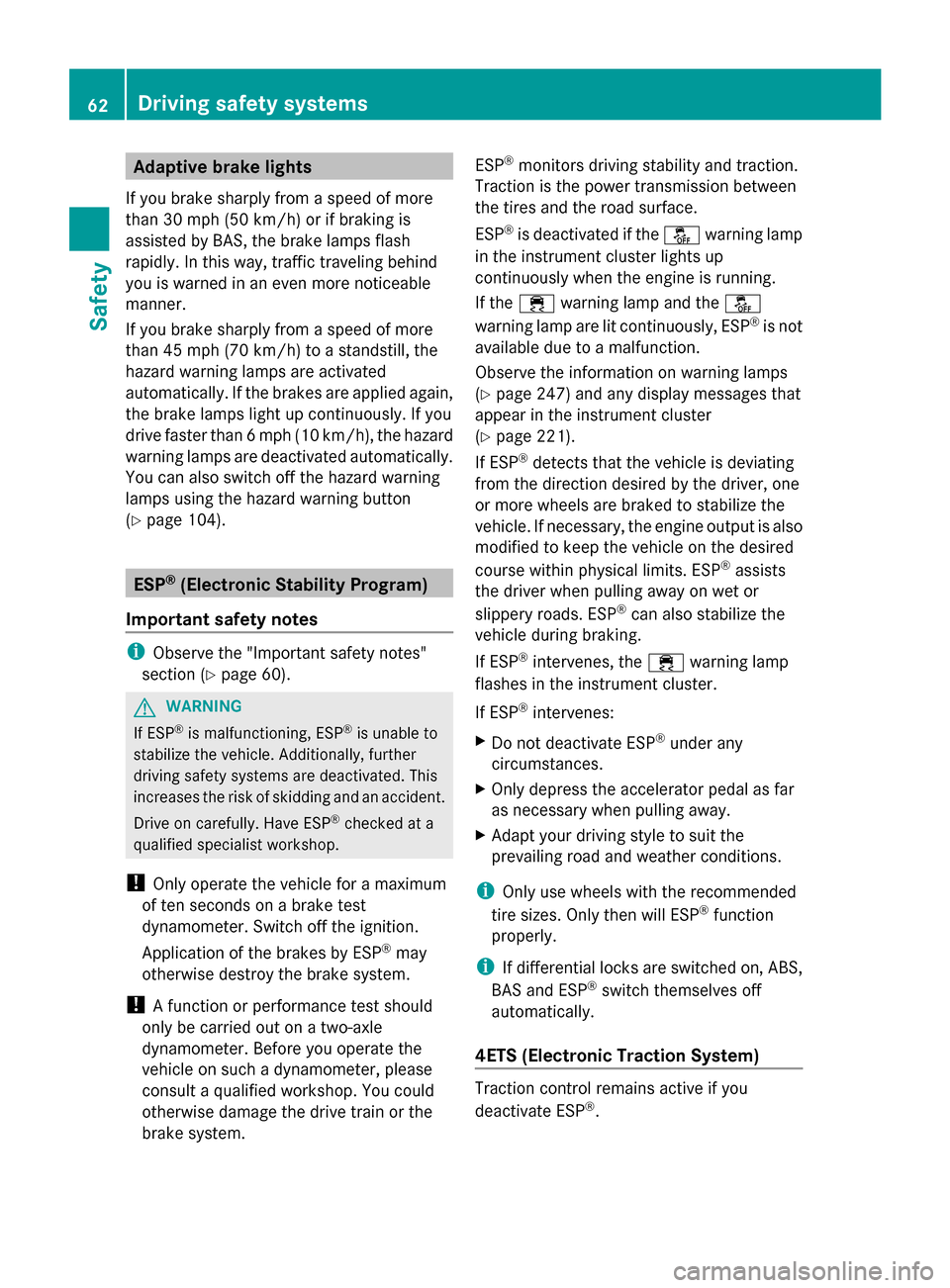
Adaptive brake lights
If you brake sharply from a speed of more
than 30 mph (50 km/h) or if braking is
assisted by BAS, the brake lamps flash
rapidly. In this way, traffic traveling behind
you is warned in an even more noticeable
manner.
If you brake sharply from a speed of more
than 45 mph (70 km/h) to a standstill, the
hazard warning lamps are activated
automatically. If the brakes are applied again,
the brake lamps light up continuously. If you
drive faster than 6 mph (10 km/h), the hazard
warning lamps are deactivated automatically.
You can also switch off the hazard warning
lamps using the hazard warning button
(Y page 104). ESP
®
(Electronic Stability Program)
Important safety notes i
Observe the "Important safety notes"
section (Y page 60). G
WARNING
If ESP ®
is malfunctioning, ESP ®
is unable to
stabilize the vehicle. Additionally, further
driving safety systems are deactivated. This
increases the risk of skidding and an accident.
Drive on carefully. Have ESP ®
checked at a
qualified specialist workshop.
! Only operate the vehicle for a maximum
of ten seconds on a brake test
dynamometer. Switch off the ignition.
Application of the brakes by ESP ®
may
otherwise destroy the brake system.
! A function or performance test should
only be carried out on a two-axle
dynamometer. Before you operate the
vehicle on such a dynamometer, please
consult a qualified workshop. You could
otherwise damage the drive train or the
brake system. ESP
®
monitors driving stability and traction.
Traction is the power transmission between
the tires and the road surface.
ESP ®
is deactivated if the 00BBwarning lamp
in the instrument cluster lights up
continuously when the engine is running.
If the 00E5 warning lamp and the 00BB
warning lamp are lit continuously, ESP ®
is not
available due to a malfunction.
Observe the information on warning lamps
(Y page 247) and any display messages that
appear in the instrument cluster
(Y page 221).
If ESP ®
detects that the vehicle is deviating
from the direction desired by the driver, one
or more wheels are braked to stabilize the
vehicle. If necessary, the engine output is also
modified to keep the vehicle on the desired
course within physical limits. ESP ®
assists
the driver when pulling away on wet or
slippery roads. ESP ®
can also stabilize the
vehicle during braking.
If ESP ®
intervenes, the 00E5warning lamp
flashes in the instrument cluster.
If ESP ®
intervenes:
X Do not deactivate ESP ®
under any
circumstances.
X Only depress the accelerator pedal as far
as necessary when pulling away.
X Adapt your driving style to suit the
prevailing road and weather conditions.
i Only use wheels with the recommended
tire sizes. Only then will ESP ®
function
properly.
i If differential locks are switched on, ABS,
BAS and ESP ®
switch themselves off
automatically.
4ETS (Electronic Traction System) Traction control remains active if you
deactivate ESP ®
. 62
Driving safety systemsSafety
Page 65 of 354
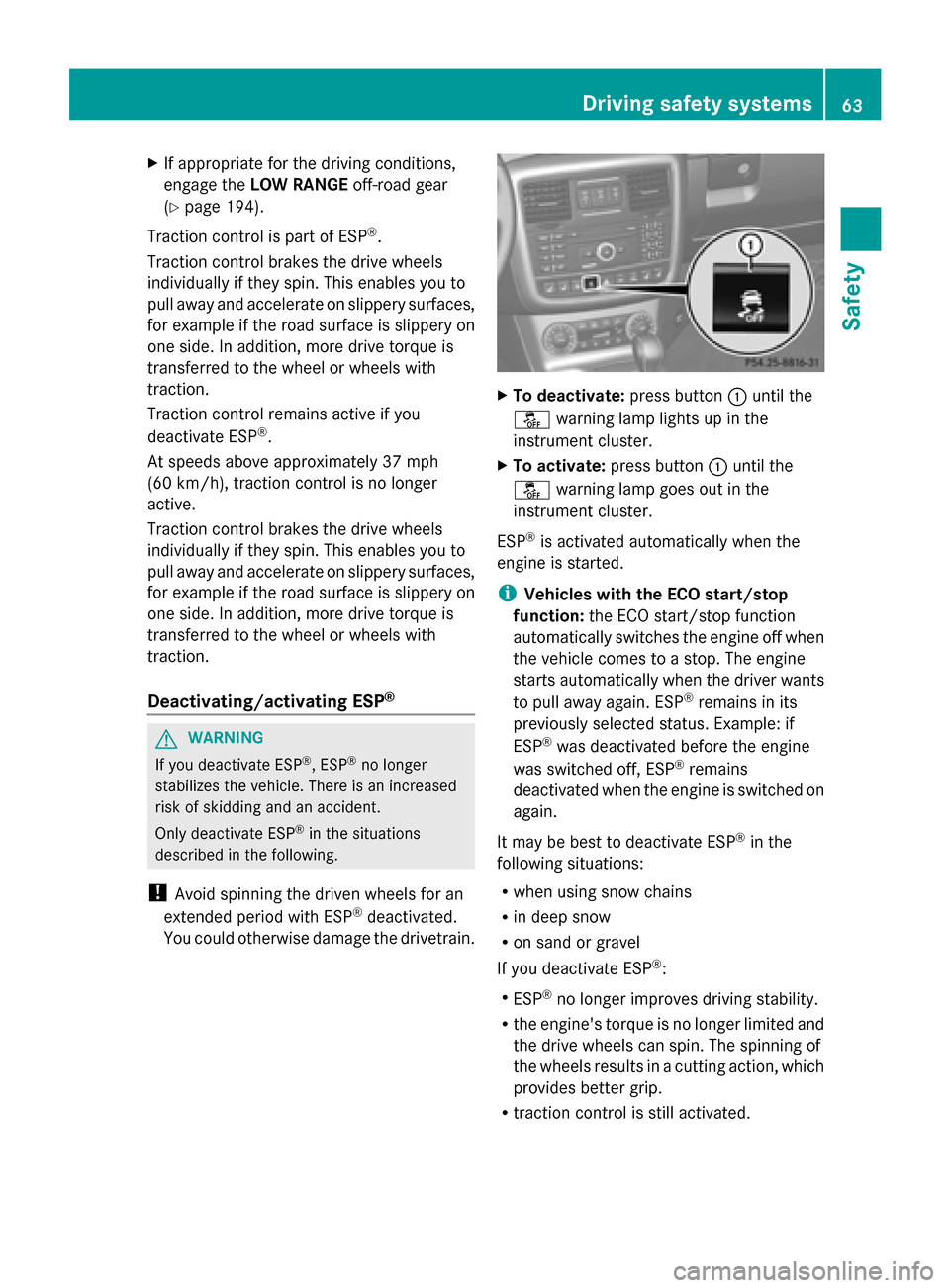
X
If appropriate for the driving conditions,
engage the LOW RANGE off-road gear
(Y page 194).
Traction control is part of ESP ®
.
Traction control brakes the drive wheels
individually if they spin. This enables you to
pull away and accelerate on slippery surfaces,
for example if the road surface is slippery on
one side. In addition, more drive torque is
transferred to the wheel or wheels with
traction.
Traction control remains active if you
deactivate ESP ®
.
At speeds above approximately 37 mph
(60 km/h), traction control is no longer
active.
Traction control brakes the drive wheels
individually if they spin. This enables you to
pull away and accelerate on slippery surfaces,
for example if the road surface is slippery on
one side. In addition, more drive torque is
transferred to the wheel or wheels with
traction.
Deactivating/activating ESP ®G
WARNING
If you deactivate ESP ®
, ESP ®
no longer
stabilizes the vehicle. There is an increased
risk of skidding and an accident.
Only deactivate ESP ®
in the situations
described in the following.
! Avoid spinning the driven wheels for an
extended period with ESP ®
deactivated.
You could otherwise damage the drivetrain. X
To deactivate: press button0043until the
00BB warning lamp lights up in the
instrument cluster.
X To activate: press button 0043until the
00BB warning lamp goes out in the
instrument cluster.
ESP ®
is activated automatically when the
engine is started.
i Vehicles with the ECO start/stop
function: the ECO start/stop function
automatically switches the engine off when
the vehicle comes to a stop. The engine
starts automatically when the driver wants
to pull away again. ESP ®
remains in its
previously selected status. Example: if
ESP ®
was deactivated before the engine
was switched off, ESP ®
remains
deactivated when the engine is switched on
again.
It may be best to deactivate ESP ®
in the
following situations:
R when using snow chains
R in deep snow
R on sand or gravel
If you deactivate ESP ®
:
R ESP ®
no longer improves driving stability.
R the engine's torque is no longer limited and
the drive wheels can spin. The spinning of
the wheels results in a cutting action, which
provides better grip.
R traction control is still activated. Driving safety systems
63Safety Z
Page 70 of 354
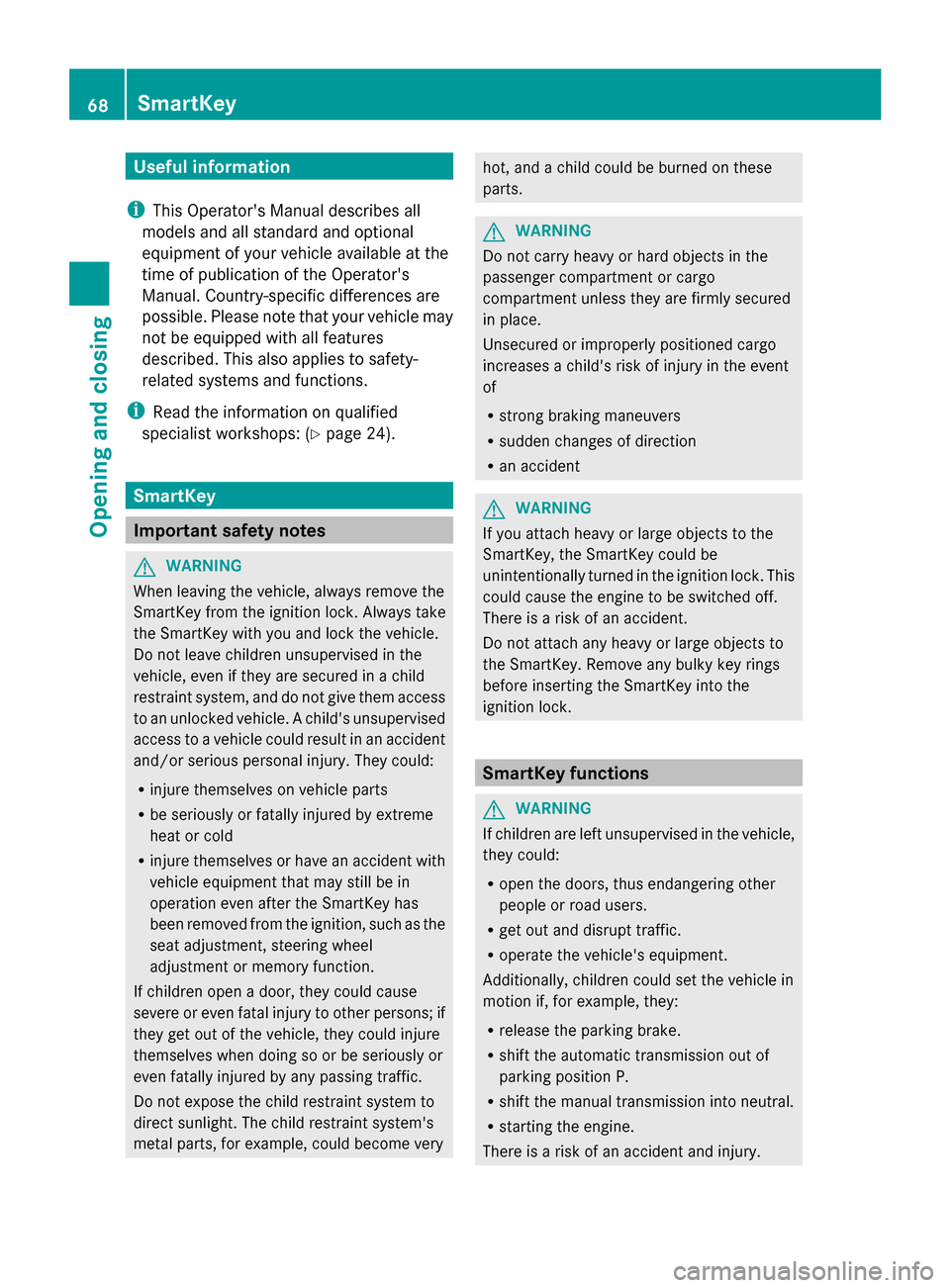
Useful information
i This Operator's Manual describes all
models and all standard and optional
equipment of your vehicle available at the
time of publication of the Operator's
Manual. Country-specific differences are
possible. Please note that your vehicle may
not be equipped with all features
described. This also applies to safety-
related systems and functions.
i Read the information on qualified
specialist workshops: (Y page 24).SmartKey
Important safety notes
G
WARNING
When leaving the vehicle, always remove the
SmartKey from the ignition lock. Always take
the SmartKey with you and lock the vehicle.
Do not leave children unsupervised in the
vehicle, even if they are secured in a child
restraint system, and do not give them access
to an unlocked vehicle. A child's unsupervised
access to a vehicle could result in an accident
and/or serious personal injury. They could:
R injure themselves on vehicle parts
R be seriously or fatally injured by extreme
heat or cold
R injure themselves or have an accident with
vehicle equipment that may still be in
operation even after the SmartKey has
been removed from the ignition, such as the
seat adjustment, steering wheel
adjustment or memory function.
If children open a door, they could cause
severe or even fatal injury to other persons; if
they get out of the vehicle, they could injure
themselves when doing so or be seriously or
even fatally injured by any passing traffic.
Do not expose the child restraint system to
direct sunlight. The child restraint system's
metal parts, for example, could become very hot, and a child could be burned on these
parts.
G
WARNING
Do not carry heavy or hard objects in the
passenger compartment or cargo
compartment unless they are firmly secured
in place.
Unsecured or improperly positioned cargo
increases a child's risk of injury in the event
of
R strong braking maneuvers
R sudden changes of direction
R an accident G
WARNING
If you attach heavy or large objects to the
SmartKey, the SmartKey could be
unintentionally turned in the ignition lock. This
could cause the engine to be switched off.
There is a risk of an accident.
Do not attach any heavy or large objects to
the SmartKey. Remove any bulky key rings
before inserting the SmartKey into the
ignition lock. SmartKey functions
G
WARNING
If children are left unsupervised in the vehicle,
they could:
R open the doors, thus endangering other
people or road users.
R get out and disrupt traffic.
R operate the vehicle's equipment.
Additionally, children could set the vehicle in
motion if, for example, they:
R release the parking brake.
R shift the automatic transmission out of
parking position P.
R shift the manual transmission into neutral.
R starting the engine.
There is a risk of an accident and injury. 68
SmartKeyOpening and closing
Page 75 of 354
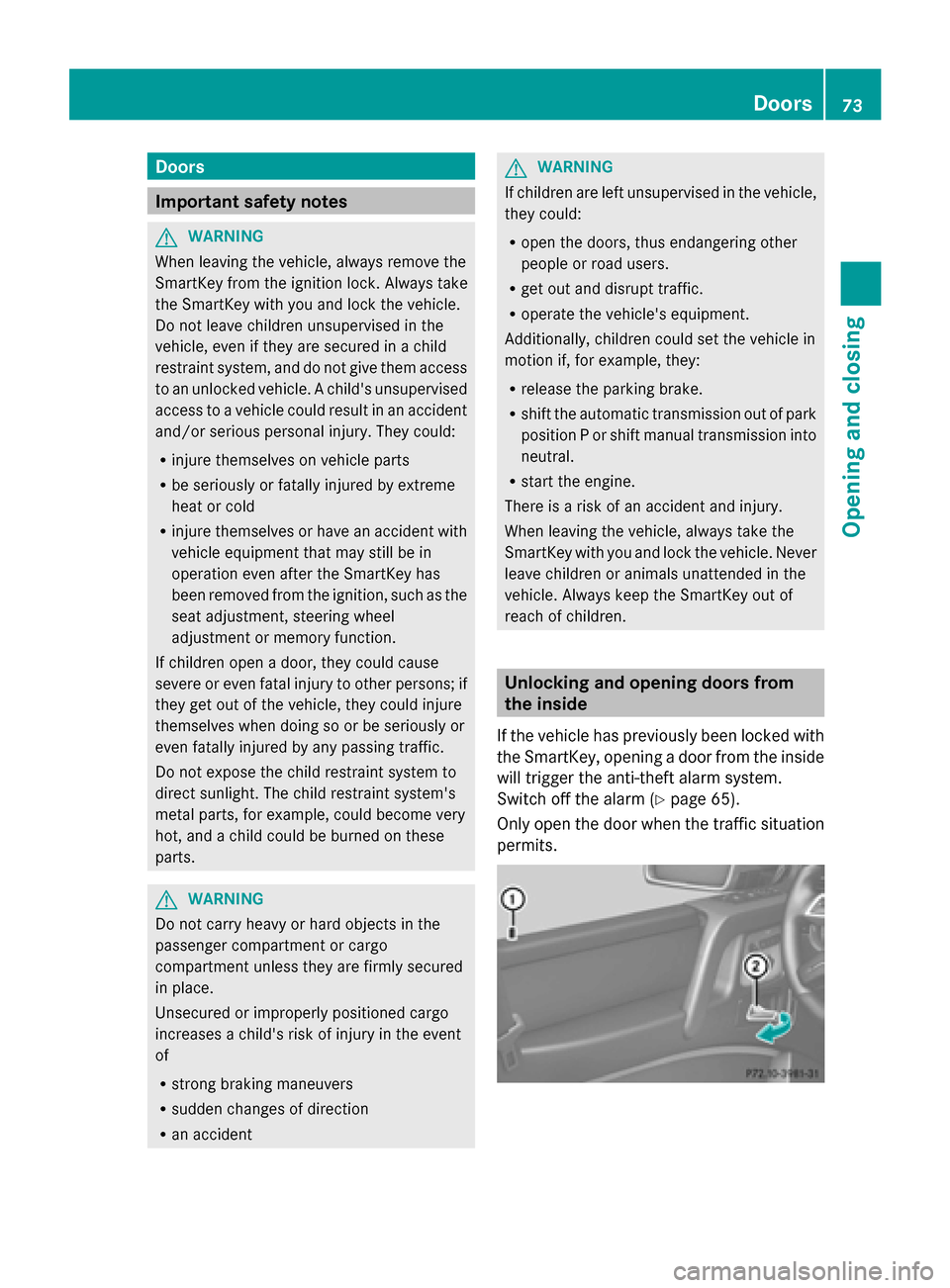
Doors
Important safety notes
G
WARNING
When leaving the vehicle, always remove the
SmartKey from the ignition lock. Always take
the SmartKey with you and lock the vehicle.
Do not leave children unsupervised in the
vehicle, even if they are secured in a child
restraint system, and do not give them access
to an unlocked vehicle. A child's unsupervised
access to a vehicle could result in an accident
and/or serious personal injury. They could:
R injure themselves on vehicle parts
R be seriously or fatally injured by extreme
heat or cold
R injure themselves or have an accident with
vehicle equipment that may still be in
operation even after the SmartKey has
been removed from the ignition, such as the
seat adjustment, steering wheel
adjustment or memory function.
If children open a door, they could cause
severe or even fatal injury to other persons; if
they get out of the vehicle, they could injure
themselves when doing so or be seriously or
even fatally injured by any passing traffic.
Do not expose the child restraint system to
direct sunlight. The child restraint system's
metal parts, for example, could become very
hot, and a child could be burned on these
parts. G
WARNING
Do not carry heavy or hard objects in the
passenger compartment or cargo
compartment unless they are firmly secured
in place.
Unsecured or improperly positioned cargo
increases a child's risk of injury in the event
of
R strong braking maneuvers
R sudden changes of direction
R an accident G
WARNING
If children are left unsupervised in the vehicle,
they could:
R open the doors, thus endangering other
people or road users.
R get out and disrupt traffic.
R operate the vehicle's equipment.
Additionally, children could set the vehicle in
motion if, for example, they:
R release the parking brake.
R shift the automatic transmission out of park
position P or shift manual transmission into
neutral.
R start the engine.
There is a risk of an accident and injury.
When leaving the vehicle, always take the
SmartKey with you and lock the vehicle. Never
leave children or animals unattended in the
vehicle. Always keep the SmartKey out of
reach of children. Unlocking and opening doors from
the inside
If the vehicle has previously been locked with
the SmartKey, opening a door from the inside
will trigger the anti-theft alarm system.
Switch off the alarm (Y page 65).
Only open the door when the traffic situation
permits. Doors
73Opening and closing Z